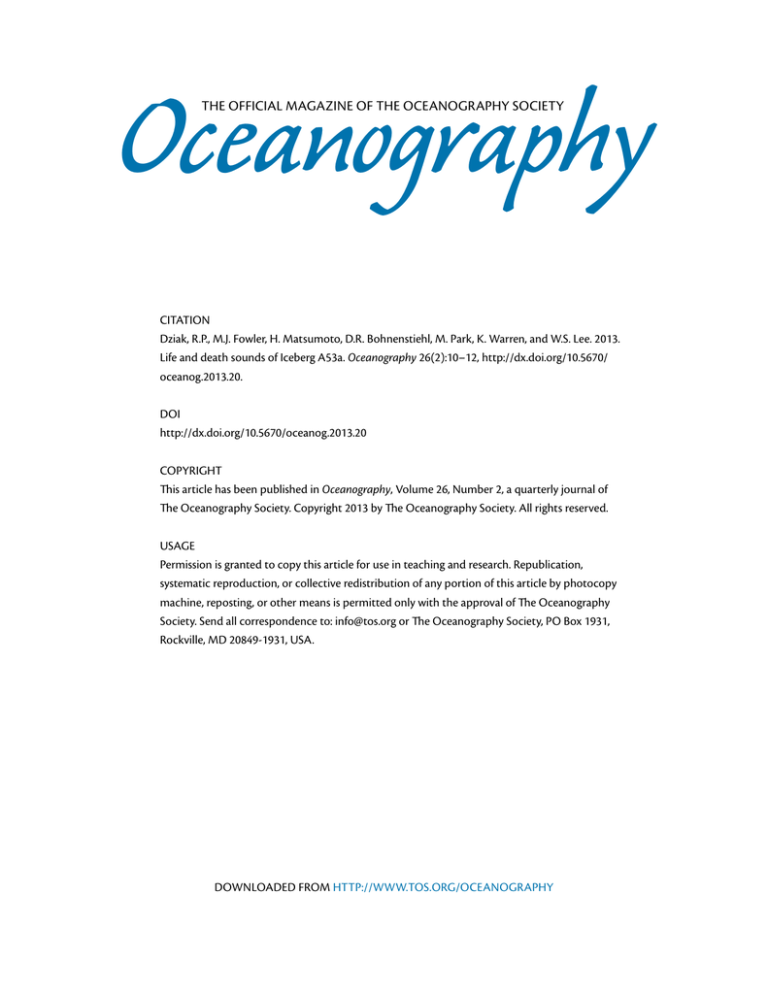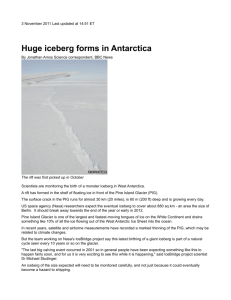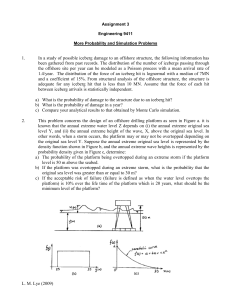
Oceanography
The Official Magazine of the Oceanography Society
CITATION
Dziak, R.P., M.J. Fowler, H. Matsumoto, D.R. Bohnenstiehl, M. Park, K. Warren, and W.S. Lee. 2013.
Life and death sounds of Iceberg A53a. Oceanography 26(2):10–12, http://dx.doi.org/10.5670/
oceanog.2013.20.
DOI
http://dx.doi.org/10.5670/oceanog.2013.20
COPYRIGHT
This article has been published in Oceanography, Volume 26, Number 2, a quarterly journal of
The Oceanography Society. Copyright 2013 by The Oceanography Society. All rights reserved.
USAGE
Permission is granted to copy this article for use in teaching and research. Republication,
systematic reproduction, or collective redistribution of any portion of this article by photocopy
machine, reposting, or other means is permitted only with the approval of The Oceanography
Society. Send all correspondence to: info@tos.org or The Oceanography Society, PO Box 1931,
Rockville, MD 20849-1931, USA.
downloaded from http://www.tos.org/oceanography
R i p C u rr e n t | N e w s i n O c e a no g r a p h y
Life and Death Sounds of Iceberg A53a
B y R ob e r t P. D z i a k , M at t h e w J . F o w l e r , H a r u y o s h i M at s u mo t o ,
D e lW ay n e R . B o h n e n s t i e h l , M i n k y u P a r k , K y l e W a rr e n , a nd Won S a n g L e e
Atmospheric and surface ocean temperatures in the Antarctic Peninsula region
have increased by a few degrees Celsius
over the last few decades, and they are
the most rapid changes recorded in the
Southern Hemisphere during this time
period (Cook et al., 2005; Meredith
and King, 2005). Associated with this
ongoing warming are ice-sheet breakup,
iceberg calving, and subsequent iceberg
grounding that are accompanied by
the release of acoustic energy into the
Southern Ocean. Although much attention has been given to the increasing
anthropogenic contributions to ocean
noise, which may be as much as 12 dB
over the last few decades (Hildebrand,
2009), the sounds created by ice breakup
at the poles may represent an under­
appreciated, yet significant, natural contribution to the ocean noise budget.
Previous acoustic studies have
tracked the paths of drifting icebergs
and characterized the sounds generated when they run aground (Scambos
et al., 2003; Muller et al., 2005; Martin
et al., 2010); however, it is unusual to
record the sound of an iceberg breaking apart in the open ocean. Here, we
present the hydroacoustic signals of
iceberg A53a as it disintegrated. We used
an array of underwater hydrophones
(250–1,000 Hz sample rate) deployed in
the Scotia Sea and Bransfield Strait off
Antarctica to record the full life-cycle
sounds of this iceberg, from grounding
harmonic tremor (HT) to “icequakes”
that occurred as it melted and broke
apart (Figure 1). These recordings permit
an assessment of the sound energy levels
projected into the marine environment
by a disintegrating iceberg.
During April–June 2007, the iceberg
A53a (~ 55 × 25 km) drifted out of the
Robert P. Dziak (robert.p.dziak@noaa.gov) is Professor, Oregon State University/
Cooperative Institute for Marine Resources Studies, National Oceanic and
Atmospheric Administration/Pacific Marine Environmental Laboratory (NOAA/
PMEL), Newport, OR, USA. Matthew J. Fowler is Research Assistant, Oregon State
University/Cooperative Institute for Marine Resources Studies, NOAA/PMEL, Newport,
OR, USA. Haruyoshi Matsumoto is Assistant Professor, Oregon State University/
Cooperative Institute for Marine Resources Studies, NOAA/PMEL, Newport, OR, USA.
DelWayne R. Bohnenstiehl is Associate Professor, Department of Marine, Earth and
Atmospheric Sciences, North Carolina State University, Raleigh, NC, USA. Minkyu Park
is Principal Research Scientist, Korea Polar Research Institute, Inchon, Republic of
Korea. Kyle Warren was a graduate student in the Department of Marine, Earth and
Atmospheric Sciences, North Carolina State University, Raleigh, NC, USA, and is currently
at WesternGeco, Houston, TX, USA. Won Sang Lee is Principal Research Scientist, Korea
Polar Research Institute, Inchon, Republic of Korea.
10
Oceanography
| Vol. 26, No. 2
Weddell Sea and through Bransfield
Strait (Figure 1A). Hydrophones first
detected HT from A53a (Figure 1B)
when it encountered a 124 m deep shoal,
which caused the berg to rotate 192°. At
this time, it began generating six days of
semicontinuous HT as it ground across
the seafloor (Figure 1A, position 1). The
iceberg then entered Bransfield Strait
where it became fixed over a 265 m deep
shoal and began to pinwheel (Figure 1A,
position 2). The HT became shorter
in duration (40–60 s) in this area. The
tremors’ fundamental frequencies, overtone spacings, and signal lengths are a
direct function of the size and duration
of the ice-seafloor contact and the speed
of the iceberg as it is driven by wind and
ocean currents (Martin et al., 2010). At
both locations, it seems likely that periodic, discrete stick-slip bursts caused by
contact of the moving iceberg with the
seafloor generated the iceberg tremors
rather than resonant vibration (Macyeal
et al., 2008; Winberry et al., 2013). The
approximate keel depth of iceberg A53a
is also given by the depth of the seafloor
at these locations, and it seems keel
depths vary significantly along the iceberg’s 60 km length.
The iceberg then drifted north during
July 2007 into the Scotia Sea, and it began
to melt in the warmer waters (Jansen
et al., 2007). Photos taken from the
International Space Station on January
15, 2008, show visible melt ponds on
the surface of the iceberg (Figure 1A,
A
D
10 km
52°S
Melt
Ponds
56°S
15 Jan 2008
60°S
64°S
55°W
2 Feb 2008
35°W
45°W
1 Mar 2008
-
68°S
B
Iceberg Harmonic Tremor
Amplitude
0
5 June 2007
C
Iceberg Disintegration
Amplitude
400
300
200
100
0
10,000
5,000
0
–5,000
–10,000
High
Frequency (Hz)
Frequency (Hz)
Low
60
120
Time (s)
180
400
300
200
100
0
3•10 4
2•10 4
1•10 4
0
–1•10 4
–2•10 4
–3•10 4
0
300
600
2 February 2008
900
Time (s)
1200
1500
Figure 1. (A) Daily position of iceberg A53a (red dots) in Bransfield Strait (BRA) and the Scotia Sea (SCO) near South Georgia Island observed using NASA’s
QuikSCAT satellite backscatter images (BYU Scatterometer Climate Record Pathfinder; http://www.scp.byu.edu). Hydrophone locations are shown as yellow
dots. Positions (1) and (2) show iceberg locations where harmonic tremor was observed, with the exact sites where tremor was produced highlighted by white
dots. Top left inset is an image of iceberg A53a on January 15, 2008, from the International Space Station, with blue melt ponds visible. (3) Location of the iceberg when these melt ponds were seen. The bottom right inset is a QuikSCAT image of A53a after the breakup event on February 2, 2008, showing hydrophone
locations of icequake sounds (green dots). (4) Iceberg location during the breakup event. (B) Example spectrogram and time series of harmonic tremor from
position 2 (see map in A). The fundamental frequency is 40 Hz, with 40 Hz overtone spacing. As many as 15 overtones are visible in the spectra. (C) Spectrogram
and time series of the February 2, 2008, icequake and breakup events recorded on the northeast Scotia hydrophone (farthest east yellow dot with “X” in A).
Note signal duration is significantly longer than the example shown in B. (D) Satellite image showing a large fracture forming in iceberg A53a as it approaches
South Georgia following the major breakup events on February 2, 2008 (http://www.esa.int/ESA). Inset global map shows the location of the study area.
top left inset). The presence of melt
ponds indicates it had entered a period
of rapid disintegration (Scambos et al.,
2003; e.g., Figure 1D); indeed, within
two months, the iceberg broke apart and
was no longer being tracked via satellite.
However, because it disintegrated within
the hydrophone array aperture, the
acoustic signature of the iceberg breaking apart while adrift could be identified.
These disintegration sounds (Figure 1C),
or icequakes, are short-duration, broadband signals (from 1–440 Hz) generated
by ice cracking and crack propagation
(similar to earthquake processes) and
are clearly distinct from the harmonic
tremor (Martin et al., 2010).
The icequake sounds (Figure 1C)
averaged ~ 220 dB-rms re 1 μPa @ 1 m,
yielding a total energy flux density of
252 dB μPa2-sec over the ~ 20 minute
duration of the entire sequence (see
Methods below). This energy flux density, which is just a fraction of the total
Oceanography
| June 2013
11
acoustic energy released during the life
of this iceberg, is equal to an energy
release of 6.9 × 107 Joules or the equivalent sound energy of ~ 214 supertankers operating over this same 20 minute
time period. These totals demonstrate
that sound from ice breakup in the
Southern Ocean can be significantly
greater than anthropogenic noise sources
and thus are a major contributor to the
overall ocean noise budget. Moreover,
the acoustic output from these massive
bergs may have unrecognized impacts
on marine animals, many of which
use sound to facilitate life-sustaining
activities such as feeding, breeding, and
navigation. Studies indicate these ice
sounds propagate over long distances
(thousands of kilometers) in the ocean
(e.g., Talandier et al., 2002; Chapp
et al., 2005), and tremors from near the
Antarctic Peninsula are readily detected
at the equator (Matsumoto et al., 2012).
Thus, it is important to continue acoustic
monitoring of the breakup of Antarctic
ice shelves to understand how spatially
and ecologically widespread their impact
is on the global ocean.
Methods
The decibel energy flux density (EFD)
of the icequake signals are estimated by
adding their decibel acoustic source levels (SL) to log10 of the total signal duration T in seconds (Warren, 2011):
EFDdB = SLdB-rms +10 log10(T) (1)
Source level for each ice breakup event
in Figure 1C was estimated by taking
the received acoustic signals at each
hydrophone, removing the hydrophone
gain, then adding in acoustic transmission loss along the signal path from
source to receiver. The amount of energy
released in Joules is estimated from the
12
Oceanography
| Vol. 26, No. 2
EFD (expressed here in linear units of
Pa2-sec) using the relation
Energy (Joules) = 2 π/ρc [EFD],
(2)
where r and c are the density
(1,000 kg m–3) and velocity (1,500 m s–1)
of seawater, respectively. The equivalent supertanker energy calculation
assumes a continuous wave source
with a bandwidth of 5–100 Hz and
195 dBrms re 1 μPa2 @ 1 m source level
(Hildebrand, 2009). The acoustic pressure recorded on a hydrophone is a time
history of ocean pressure perturbations
(ΔP) relative to background ocean pressure at the recording water depth. These
excess ocean sound pressures are usually
small (~ 10–2 Pa), and it has been the
standard in the ocean acoustic literature
to express sound pressure in log-scale
decibels (dB) relative to a reference
pressure (Po) of 1 μPa (Urick, 1975).
Moreover, it is convention to use 1 m as
the reference distance (ro) when calculating the acoustic pressure of the source.
Acknowledgements
This work was sponsored by the
NOAA Ocean Exploration and
Research Program and the Korea Polar
Research Institute, projects PE13050
and PM12020. PMEL contribution
number 4003.
Reference s
Chapp, E., D.R. Bohnenstiehl, and M. Tolstoy.
2005. Sound-channel observations of icegenerated tremor in the Indian Ocean.
Geochemistry Geophysics Geosystems 6, Q06003,
http://dx.doi.org/10.1029/2004GC000889.
Cook, A.J., A.J. Fox, D.G. Vaughan, and
J.G. Ferrigno. 2005. Retreating glacier fronts
on the Antarctic Peninsula over the past halfcentury. Science 308:541–544, http://dx.doi.org/
10.1126/science.1104235.
Hildebrand, J. 2009. Anthropogenic and natural
sources of ambient noise in the ocean. Marine
Ecology Progress Series 395:5–20, http://
dx.doi.org/10.3354/meps08353.
Jansen, D., M. Schodlok, and W. Rack. 2007. Basal
melting of A-38B: A physical model constrained
by satellite observations. Remote Sensing of
Environment 111:195–203, http://dx.doi.org/
10.1016/j.rse.2007.03.022.
MacAyeal, D.R., E.A. Okal, R.C. Aster, and
J.N. Bassis. 2008. Seismic and hydroacoustic
tremor generated by colliding icebergs. Journal
of Geophysical Research 113, F03011, http://
dx.doi.org/10.1029/2008JF001005.
Martin, S., R. Drucker, R. Aster, F. Davey, E. Okal,
T. Scambos, and D. MacAyeal. 2010. Kinematic
and seismic analysis of giant tabular iceberg
breakup at Cape Adare, Antarctica. Journal
of Geophysical Research 115, B06311, http://
dx.doi.org/10.1029/2009JB006700.
Matsumoto, H., R. Dziak, M. Park, T.-K. Lau,
W.-S. Lee, D. Bohnenstiehl, J. Haxel,
K. Stafford, and D. Mellinger. 2012. Sound of
climate change: Anthropogenic impact to the
world oceans. Poster presented at Scientific
Committee Antarctic Research: Antarctic
Science and Policy Advice in a Changing World,
Session 6, July 16–19, 2012, Portland, OR.
Meredith, M.P., and J.C. King. 2005. Rapid
climate change in the ocean west of the
Antarctic Peninsula during the second half
of the 20th century. Geophysical Research
Letters 32, L19604, http://dx.doi.org/
10.1029/2005GL024042.
Muller, C., V. Schlindwein, A. Eckstaller,
and H. Miller. 2005. Singing icebergs.
Science 310:1,299, http://dx.doi.org/10.1126/
science.1117145.
Scambos, T.A., C. Hulbe, and M.A. Fahnestock.
2003. Climate-induced ice shelf disintegration in the Antarctic Peninsula. Pp. 79–92
in Antarctic Peninsula Climate Variability:
Historical and Paleoenvironmental Perspectives.
E. Domack, A. Leventer, A. Burnett,
R. Bindschadler, P. Convey, and M. Kirby, eds,
Antarctic Research Series, vol. 79, American
Geophysical Union, Washington, DC, http://
dx.doi.org/10.1029/AR079p0079.
Talandier, J., O. Hyvernaud, E.A. Okal, and
P.-F. Piserchia. 2002. Long range detection of
hydroacoustic signals from large icebergs in
the Ross Sea, Antarctica. Earth and Planetary
Science Letters 203:519– 534, http://dx.doi.org/
10.1016/S0012-821X(02)00867-1.
Urick, R.J. 1975. Principles of Underwater Sound.
Kingsport Press, 384 pp.
Warren, K. 2011. Underwater acoustic energy
generated by icebergs in the Scotia Sea.
M.S. Thesis, North Carolina State University,
100 pp, http://repository.lib.ncsu.edu/ir/
handle/1840.16/7365?mode=full.
Winberry, J.P., S. Anandakrishnan, D.A. Wiens,
and R.B. Alley. 2013. Nucleation and seismic
tremor associated with the glacial earthquakes
of Whillans Ice Stream, Antarctica. Geophysical
Research Letters 40:312–315, http://dx.doi.org/
10.1002/grl.50130.





